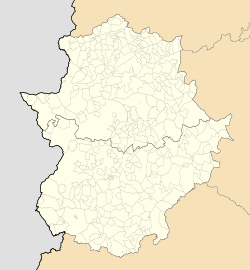Olivenza
Olivença | |
|---|---|
Municipality | |
 | |
 | |
Location in the Spanish–Portuguese border | |
| Coordinates: 38°41′9″N 7°6′3″W / 38.68583°N 7.10083°W | |
| Country | Spain[a] |
| Autonomous community | Extremadura |
| Province | Badajoz |
| Government | |
| • Mayor | Manuel José González Andrade (PSOE) |
| Area | |
| • Total | 430.1 km2 (166.1 sq mi) |
| Elevation | 327 m (1,073 ft) |
| Population (2018)[1] | |
| • Total | 11,986 |
| • Density | 28/km2 (72/sq mi) |
| Time zone | UTC+1 (CET) |
| • Summer (DST) | UTC+2 (CEST) |
| Postal code | 06100 |
| Website | Town Hall (in Spanish) |
Olivenza (Spanish: [oliˈβenθa] ) or Olivença (Portuguese: [oliˈvẽsɐ]) is a town in southwestern Spain, close to the Portugal–Spain border. It is a municipality belonging to the province of Badajoz, and to the wider autonomous community of Extremadura.
The town of Olivença was under Portuguese sovereignty continuously between 1297 (Treaty of Alcañices) and 1801, when it was occupied by Spain during the War of the Oranges and ceded that year under the Treaty of Badajoz. Spain has since administered the territory (now split into two municipalities, Olivenza and Táliga), whereas Portugal invokes the self-revocation of the Treaty of Badajoz, plus the Congress of Vienna of 1815, to claim the return of the territory. In spite of the territorial dispute between Portugal and Spain, the issue has not been a sensitive matter in the relations between these two countries.[2][3]
Olivenza and other neighbouring Spanish (La Codosera, Alburquerque and Badajoz) and Portuguese (Arronches, Campo Maior, Estremoz, Portalegre and Elvas) towns reached an agreement in 2008 to create a euroregion.[4][5]
Cite error: There are <ref group=lower-alpha> tags or {{efn}} templates on this page, but the references will not show without a {{reflist|group=lower-alpha}} template or {{notelist}} template (see the help page).
- ^ Municipal Register of Spain 2018. National Statistics Institute.
- ^ Merida, J. C. Z. (5 September 2003). "Portugal desmiente a la CIA y niega que haya un conflicto por Olivenza". El Periódico Extremadura (in Spanish). Archived from the original on 26 July 2011.
- ^ "Martins da Cruz Afirma Que a Questão de Olivença "Está Congelada"". Grupo dos Amigos de Olivença (in Portuguese). 5 September 2003. Archived from the original on 9 March 2016. Retrieved 3 September 2008.
- ^ Leon, F. (18 March 2008). "Europacto en la frontera hispano-lusa". El Periódico Extremadura (in Spanish). Archived from the original on 26 July 2011.
- ^ "Euroregião e Declaração de Olivença". www.cm-estremoz.pt (in Portuguese). [permanent dead link]



